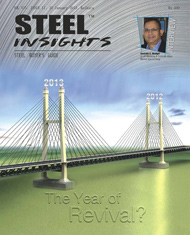If the iron ore price has fallen by more than 40% over the past two years why are the biggest producers of the steel-making material continuing to expand production?
The answer to that seemingly tricky question is simple. Because even at the latest price of around $94 a tonne the world’s biggest miners of iron ore are still operating on a profit margin of more than 100%.
Managers in most other industries can only dream about producing a product for around $45 a ton and selling it for $94 a tonne.
It Was A 200% Margin Last Year
It was better in early 2013 when the price of iron ore was $160 a ton, but even the Australian management teams at Rio Tinto, BHP Billiton and the Brazilians in charge of Vale probably found a profit margin of more than 200% somewhat embarrassing.
Misunderstanding the margins available to the world’s major producers of iron ore is one of the common mistakes when analyzing the biggest miners of the stuff.
Another mistake is to image that somehow the world is creating a monstrous stockpile of surplus iron ore because the industry has shifted from a period of supply shortage to a period when supply outstrips demand.
Easy as it is to draw a graph showing iron ore over-supply exceeding 250 million tons a year from 2016 onwards, which it theoretically could, the reality is that no-one has the storage space to create a man-made mountain of iron ore that size, nor the port space or ships in which to store it, nor the capital to fund the stockpile.
Business 101: Out Go The High Cost Miners
What will actually happen is straight from a Business 101 class. The surplus material appearing on the spreadsheets of mining analysts will never be mined because at a time of surplus it is the high cost producers who simply disappear from the equation, either by mothballing their mines, or by being tipped into some form of insolvency.
The first failures in the Australian iron ore industry have occurred over the past few weeks, and all involve small or high cost business. IMX Resources called in receivers for its Termite Resources mine in South Australia. Sherwin Iron fell into the hands of a receiver when it ran out of the cash required to develop its Roper River mine in the Northern Territory, and Pluton Resources is in a trading halt on the Australian stock exchange as it seeks funds to expand its Cockatoo Island mine.
The tough times hitting high cost producers was confirmed yesterday by one of the local favorites in the once red-hot iron ore sector, Atlas Iron. It reported that production in the three months to June 30 was only marginally profitable thanks to hefty discounts enforced by Asian steel mills which are increasingly dictating business terms.
High-Grading Creeps Into The Industry
Atlas also revealed a fresh change in the market by announcing that it would severely limit production of its lowest grade ore and focus on the material which attracts the highest price, an event known in mining as “high-grading” and a step normal only taken in the toughest of times because it can shorten a mine’s life, and could raise questions about the ongoing value of ore in the ground.
Meanwhile, over at the world’s biggest miners of iron ore there is a no-brainer business decision to be made; to expand or to not expand when the profit margin on new ore is more than 100%.
As they say in the Australian outback even the drover’s dog could make that decision.
Source; Forbes
- metaljunction »
- Metal News
Metal News & Events
METALJUNCTION PUBLICATIONS
Coal Insights (English) Monthly

Coal Insights is a ready reckoner for anyone associated with coal. This publication is aimed at tracking everything related to coal in India.
India Coal Market Watch(English) Monthly

ICMW is a one-stop source for all news, data and research pertaining to coal demand, consumption, stocks, spot- and long-term prices with respect to the Indian Market.
India Steel Market Watch (English) Monthly

ISMW is a brand new high-end steel market report, covering all aspects of the steel industry in India.
Steel Insights(English) Monthly

Steel Insights delves into various facets of the domestic and global steel industry such as market fundamentals, raw material price trends, price forecasts etc.